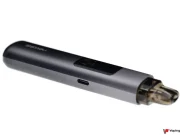A study titled, Comparing the cancer potencies of emissions from vapourised nicotine products including e-cigarettes with those of tobacco smoke, carried out by Dr William E Stephens from the University of St Andrews in the UK, looked into the risks from inhaling vapor in comparison to those from inhaling smoke.
The cancer risk for several nicotine-containing aerosols were modelled using published chemical analyses of vapor emissions and their correlational risks, and then compared to those of cigarette smoke.
“The aerosols form a spectrum of cancer potencies spanning five orders of magnitude from uncontaminated air to tobacco smoke. E-cigarette emissions span most of this range with the preponderance of products having potencies<1% of tobacco smoke and falling within two orders of magnitude of a medicinal nicotine inhaler “ read the study abstract.
Certain factors can affect the risk potency
“Optimal combinations of device settings, liquid formulation and vaping behaviour normally result in e-cigarette emissions with much less carcinogenic potency than tobacco smoke,” concluded the study. The study author added that there are instances where the cancer risks are elevated more than usual, but this can normally be avoided via known factors such as the above.
Researches have based their analysis on a regular use of cigarettes (15 cigarettes per day) and ecigs (30 ltr of vapor per day). But what amount of puffs per day does it really make for vaping ?
Based on data brought forward by Farsalinos himself in 2016, this vapor volume could correspond to approximately 375 puffs per day in indirect inhalation (lung or mouth to MTL (Mouth to Lung). This equates to a volume of 60 to 80 ml of air inhaled per puff, with 30 ltr of steam converted into 30 000 milliliter or 30 000/80 = 375 puffs. According to this data, in direct inhalation or DLI (Direct Lung Inhalation), the volume changes dramatically, and can range from 1000 to 1500 steam milliliter inhaled per puff. In Fact Farsalinos, has been warning vapers against this technique for some time. This points out that if one aims to reach between 30 and 20 puffs per day by direct inhalation (30 000/1500 = 20), one will reach the 30 ltr inhaled vapor described in this study.




![Recent Conference Urged Nations Worldwide to “Quit [Smoking] Like Sweden”](https://www.vapingpost.com/wp-content/uploads/2024/04/vape-conference-238x178.png)




![Recent Conference Urged Nations Worldwide to “Quit [Smoking] Like Sweden”](https://www.vapingpost.com/wp-content/uploads/2024/04/vape-conference-180x135.png)



Vapers are so cool, bro.